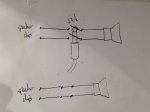Tom Overthere
Member
I'm building a pair of single-driver reference monitors (poor man's Auratones). I want to be able to feed signal to them two ways:
I've included pictures, and have labeled the various potential solder points.
If I were just using the red-and-black spring clips, I assume the wiring would run:
I'm confused about how to include the 1/4" jack. 'E' is obviously a solder point, but shouldn't there be a second solder point - F, G or H?
And...I don't know which wire--red or black--goes where on the 1/4" jack.
Please tell me how to wire this so I can drive the speaker by both the speaker wire clips and the 1/4" jack.
If you put it in simple terms like "C to E to A" I'll understand.
Thanks
1. by standard hi-fi speaker wire, red-and-black spring clips mounted to the speaker's back
2. by 1/4" mono TRS jack mounted through the speaker's back
2. by 1/4" mono TRS jack mounted through the speaker's back
I've included pictures, and have labeled the various potential solder points.
If I were just using the red-and-black spring clips, I assume the wiring would run:
C ----> A
D ----> B
Correct me if I'm wrong (duh).
D ----> B
Correct me if I'm wrong (duh).
I'm confused about how to include the 1/4" jack. 'E' is obviously a solder point, but shouldn't there be a second solder point - F, G or H?
And...I don't know which wire--red or black--goes where on the 1/4" jack.
Please tell me how to wire this so I can drive the speaker by both the speaker wire clips and the 1/4" jack.
If you put it in simple terms like "C to E to A" I'll understand.
Thanks





 )
) Let's see how my luck holds in this instance.
Let's see how my luck holds in this instance. 


